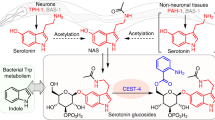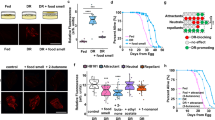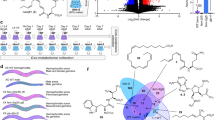Abstract
The functions of serotonin have been assigned through serotonin-receptor-specific drugs and mutants1,2; however, because a constellation of receptors remains when a single receptor subtype is inhibited, the coordinate responses to modulation of serotonin levels may be missed. Here we report the analysis of behavioural and neuroendocrine defects caused by a complete lack of serotonin signalling. Analysis of the C. elegans genome sequence showed that there is a single tryptophan hydroxylase gene (tph-1)—the key enzyme for serotonin biosynthesis. Animals bearing a tph-1 deletion mutation do not synthesize serotonin but are fully viable. The tph-1 mutant shows abnormalities in behaviour and metabolism that are normally coupled with the sensation and ingestion of food: rates of feeding and egg laying are decreased; large amounts of fat are stored; reproductive lifespan is increased; and some animals arrest at the metabolically inactive dauer stage. This metabolic dysregulation is, in part, due to downregulation of tranforming growth factor-β and insulin-like neuroendocrine signals. The action of the C. elegans serotonergic system in metabolic control is similar to mammalian serotonergic input to metabolism and obesity2.
This is a preview of subscription content, access via your institution
Access options
Subscribe to this journal
Receive 51 print issues and online access
$199.00 per year
only $3.90 per issue
Buy this article
- Purchase on Springer Link
- Instant access to full article PDF
Prices may be subject to local taxes which are calculated during checkout




Similar content being viewed by others
References
Sanders-Bush, E. & Mayer, S. E. in Goodman & Gilman's Pharmacological Basis of Therapeutics 9th edn (eds Hardman, J. G. et al.) 249–263 (McGraw-Hill, New York, 1996).
Leibowitz, S. F. & Alexander, J. T. Hypothalamic serotonin in control of eating behaviour, meal size, and body weight. Biol. Psychiatry 44, 851–864 (1998).
Loer, C. M., Davidson, B. D. & McKerrow, J. M. A phenylalanine hydroxylase gene from the nematode C. elegans is expressed in the hypodermis. J. Neurogenet. 13, 157–180 (1999).
D'Sa, C. M., Arthur, R. E. Jr & Kuhn, D. M. Expression and deletion mutagenesis of tryptophan hydroxylase fusion proteins: delineation of the enzyme catalytic core. Neurochem. 67, 917–926 (1996).
Rand, J. B. & Nonet, M. L. Synaptic Transmission in C. elegans II (eds Riddle, D. L. et al.) 611–643 (Cold Spring Harbor Laboratory Press, New York, 1997).
Jansen, G., Hazendonk, E., Thijssen, K. L. & Plasterk, R. H. Reverse genetics by chemical mutagenesis in C. elegans. Nature Genet. 17, 119–121 (1997).
Horvitz, H. R., Chalfie, M., Trent, C., Sulston, J. E. & Evans, P. D. Serotonin and octopamine in the nematode C. elegans. Science 216, 1012–1014 (1982).
Avery, L. & Horvitz, H. R. Effects of starvation and neuroactive drugs on feeding in C. elegans. J. Exp. Zool. 253, 263–270 (1990).
Sulston, J., Dew, M. & Brenner, S. Dopaminergic neurons in the nematode Caenorhabditis elegans. J. Comp. Neuro. 163, 215–226 (1975).
Weinshenker, D, Garriga, G. & Thomas, J. H. Genetic and pharmacological analysis of neurotransmitters controlling egg laying in C. elegans. J. Neurosci 15, 6975–6985 (1995).
Waggoner, L. E., Zhou, G. T., Schafer, R. W. & Schafer, W. R. Control of alternative behavioural states by serotonin in Caenorhabditis elegans. Neuron 21, 203–214 (1998).
Duerr, J. S. et al. The cat-1 gene of Caenorhabditis elegans encodes a vesicular monoamine transporter required for specific monoamine-dependent behaviours. J. Neurosci. 19, 72–84 (1999).
Riddle, D. L. Genetic and Environmental Regulation of Dauer Larva Development in C. elegans II. (eds Riddle, D. L. et al.) 739–768 (Cold Spring Harbor Laboratory Press, New York, 1997).
Kimura, K. D., Tissenbaum, H. A., Liu, Y. & Ruvkun, G. daf-2, an insulin receptor-like gene that regulates longevity and diapause in C. elegans. Science 277, 942–946 (1997).
Ren, P. F. et al. Control of C. elegans larval development by neuronal expression of a TGF-β homolog. Science 274, 1389–1391 (1996).
Schackwitz, W. S., Inoue, T. & Thomas, J. H. Chemosensory neurons function in parallel to mediate a pheromone response in C. elegans. Neuron 17, 719–728 (1996).
Bargmann, C. Neurobiology of the C. elegans genome. Science 282, 2028–2033 (1998).
Zwaal, R. R., Mendel, J. E., Sternberg, P. W. & Plasterk, R. H. A. Two neuronal G proteins are involved in chemosensation of the C. elegans dauer-inducing pheromone. Genetics 145, 715–727 (1997).
Ogg, S. et al. The Fork head transcription factor DAF-16 transduces insulin-like metabolic and longevity signals in C. elegans. Nature 389, 994–999 (1997).
Patterson, G. I., Koweek, A., Wong, A., Liu, Y. & Ruvkun, G. The DAF-3 Smad protein antagonizes TGF-β-related receptor signaling in the C. elegans dauer pathway. Genes Dev. 11, 2679–2690 (1997).
Kenyon, C., Chang, J., Gensch, E., Rudner, A. & Tabtiang, R. A. C. elegans mutant that lives twice as long as wild type. Nature 366, 461–464 (1993).
Gems, D. et al. Two pleiotropic classes of daf-2 mutation affect larval arrest, adult behaviour, reproduction and longevity in Caenorhabditis elegans. Genetics 150, 129–155 (1998).
Conradt, B. & Horvitz, H. R. The C. elegans protein EGL-1 is required for programmed cell death and interacts with the Bcl-2-like protein CED-9. Cell 93, 519–529 (1998).
Duret, L. Gues, N., Peitsch, M. & Bairoch, A. New insulin-like proteins with atypical disulfide bond pattern characterized in C. elegans by comparative sequence analysis and homology modeling. Genome Res. 8, 348–353 (1998).
Peschke, E., Peschke, D., Hammer, T. & Csernus, V. Influence of melatonin and serotonin on glucose-stimulated insulin release from perifused rat pancreatic islets in vitro. J. Pineal Res. 23, 156–163 (1997).
Breum, L., Bjerre, U., Bak, J. F., Jacobsen, S. & Astrup, A. Long-term effects of fluoxetine on glycemic control in obese patients with non-insulin-dependent diabetes mellitus or glucose intolerance: influence on muscle glycogen synthase and insulin receptor kinase activity. Metabolism 44,1570–1576 (1995).
Avery, L. The genetics of feeding in Caenorhabditis elegans. Genetics 133, 897–917 (1993).
Lakowski, B. & Hekimi, S. The genetics of caloric restriction in Caenorhabditis elegans. Proc. Natl Acad. Sci. USA 95,13091–13096 (1998).
Nonogaki, K., Strack, A. M., Dallman, M. F. & Tecott, L. H. Leptin-independent hyperphagia and type 2 diabetes in mice with a mutated serotonin 5-HT2C receptor gene. Nature Med. 4, 1152–1156 (1998).
Barzilai, A., Kennedy, T. E., Sweatt, J. D. & Kandel, E. R. 5-HT modulates protein synthesis and the expression of specific proteins during long-term facilitation in Aplysia sensory neurons. Neuron 2, 1577–1586 (1989).
Acknowledgements
We thank P. Sternberg, S. Nurrish and J. Kaplan for advice on serotonin regulation of behaviour; members of the Ruvkun lab for critical reading of the manuscript. R. Lee for help with graphics; G. Sandoval for some strain characterizations; A. Lander for advice on his microscope and software, and especially R. Lints and S. Emmons for analysing the dopamine accumulation in tph-1(mg280). J.Y.S. was supported by a fellowship from the National Institutes of Health, M.V. by a fellowship from the DAAD German Academic Exchange Service, C.M.L. by NSF. This work was supported by grants from Hoechst AG to G.R., and grants from NIH to Y.S. Some nematode strains were supplied by the Caenorhabditis Genetics Center supported by the NIH and the University of Minnesota.
Author information
Authors and Affiliations
Corresponding author
Rights and permissions
About this article
Cite this article
Sze, J., Victor, M., Loer, C. et al. Food and metabolic signalling defects in a Caenorhabditis elegans serotonin-synthesis mutant. Nature 403, 560–564 (2000). https://doi.org/10.1038/35000609
Received:
Accepted:
Issue Date:
DOI: https://doi.org/10.1038/35000609
This article is cited by
-
Parallel pathways for serotonin biosynthesis and metabolism in C. elegans
Nature Chemical Biology (2023)
-
A gut feeling
Nature Chemical Biology (2023)
-
Endocrine, genetic, and microbiome nexus of obesity and potential role of postbiotics: a narrative review
Eating and Weight Disorders - Studies on Anorexia, Bulimia and Obesity (2023)
-
Chemical cognition: chemoconnectomics and convergent evolution of integrative systems in animals
Animal Cognition (2023)
-
Serotonin and dopamine modulate aging in response to food odor and availability
Nature Communications (2022)
Comments
By submitting a comment you agree to abide by our Terms and Community Guidelines. If you find something abusive or that does not comply with our terms or guidelines please flag it as inappropriate.



